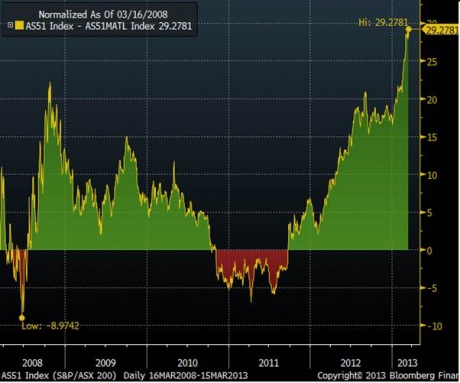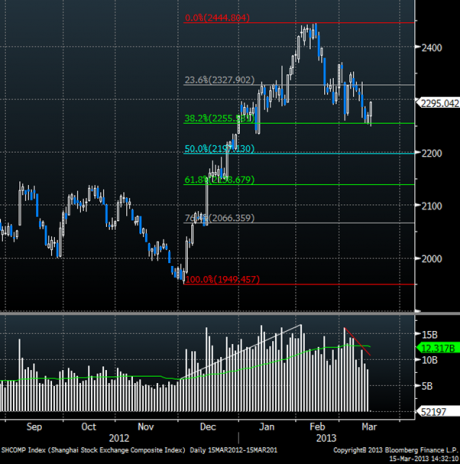MARKETS SPECTATOR: Are we really resource full?
The major reason the market has consolidated over recent weeks has been the sharp downturn in resources stocks. BHP and Rio alone make up 11.3 per cent of the broader index so when they retreat more than 10 per cent, it makes it very difficult for the broader index to make headway.
The chart below is the spread between the S&P/ASX 200 and ASX 200 Materials index. It shows that the ASX 200 is currently outperforming the materials index by 29 per cent, which is the largest amount in five years. To put it into perspective, the ASX 200 has outperformed the materials sector by an average of 6 per cent over the last five years. So for those who believe in mean reversion, this is definitely something worth watching.
It doesn’t come as a surprise to see that the recent peak in the materials sector coincided almost perfectly with the peak on the Shanghai Composite Index. The chart below shows this perfectly, while the ASX 200 index in white has largely gone sideways.
This peak in both markets seems to have been triggered by concerns over the Chinese housing market. Both the Shanghai Composite and materials index topped out about the same time as new data showed a jump in Chinese property prices and the subsequent announcement of curbs against real estate speculation. Either way, it’s certainly caused some money to flow out of China-facing assets amid concerns it will lower the demand for commodities used in construction materials.
However, I don’t think all is lost. In fact, as I mentioned above, I think this is a space one should watch very closely as I don’t think we are too far away from a low. I’m never one to try and catch the falling knife, so to speak, I’d rather wait for it to stick in the floor before stepping in to buy.
From a technical analysis perspective, there are some encouraging signs worth noting on the Shanghai Composite chart. Firstly, the Shanghai Composite has had an incredible run, surging 25 per cent in a little over eight weeks. Putting that into context, it’s taken the S&P/ASX 200 roughly eight months to do the same.
Whenever a market moves that far in such a short period of time, the correction/pullback will always be a bit deeper than if it had taken a much longer period of time. So far the correction in the Shanghai Composite is around 8 per cent, which in the context of a 25 per cent rally is pretty reasonable in my books. Using Fibonacci retracements, the below chart shows good buying support around the 38.2 per cent retracement level.
It is generally regarded that during uptrends, pullbacks should not retrace more than the 38 per cent levels. The shallower they are the more buying interest/lack of selling pressure present. Another big positive to note is the huge expansion in volume we saw when the market rallied from late November, 2012. Equally important is the declining volumes during the pullback, as depicted by the downtrend line in the below volume chart. It indicates a decreasing amount of selling volume.
The textbook uptrend is one that rises on increasing volume and pulls back on decreasing volume, which looks to be the case at the moment in China.
I’ve not shown the charts of Rio Tinto and BHP, but one can easily see that both stocks are at or very close to significant support levels, which may very well act as a reversal point in the not too distant future.
If you believe that Chinese GDP growth has bottomed, like I do, then you can probably understand where I am coming from. Globally, the world is recovering and that includes China’s biggest trading partners.
I am probably a little early on this but I think there is going to be a great contrarian investment opportunity not too far around the corner, probably like Australia’s discretionary retailers three to six months ago.
The other thing I like from a contrarian point of view is the amount of downgrades coming through for the mining sector. Analysts and research houses have a history of being most bullish at the top and most bearish at the bottom. It’s becoming hard to find people bullish on miners, which speaks volumes in itself.
Remember, it’s always darkest before dawn.



















